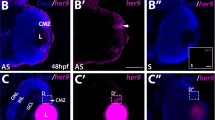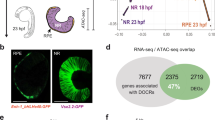Abstract
Development of the vertebrate eye requires a series of steps including specification of the anterior neural plate, evagination of the optic vesicles from the ventral forebrain, and the cellular differentiation of the lens and retina. Homeobox-containing genes, especially the transcription regulator Pax6, play a critical role in vertebrate and invertebrate eye formation. Mutations in Pax6 function result in eye malformations known as Aniridia in humans and Small eye syndrome in mice1,2,3. The Drosophila homologue of Pax6, eyeless, is also necessary for correct invertebrate eye development, and its misexpression leads to formation of ectopic eyes in Drosophila4,5. Here we show that a conserved vertebrate homeobox gene, Rx, is essential for normal eye development, and that its misexpression has profound effects on eye morphology. Xenopus embryos injected with synthetic Rx RNA develop ectopic retinal tissue and display hyperproliferation in the neuroretina. Mouse embryos carrying a null allele of this gene do not form optic cups and so do not develop eyes. The Rx gene family plays an important role in the establishment and/or proliferation of retinal progenitor cells.
This is a preview of subscription content, access via your institution
Access options
Subscribe to this journal
Receive 51 print issues and online access
$199.00 per year
only $3.90 per issue
Buy this article
- Purchase on Springer Link
- Instant access to full article PDF
Prices may be subject to local taxes which are calculated during checkout






Similar content being viewed by others
References
Ton, C. C. T. et al. Positional cloning and characterization of a paired box and homeobox-containing gene from the aniridia region. Cell 67, 1059–1074 (1991).
Glaser, T. et al. PAX6 gene dosage effect in a family with congenital cataracts, aniridia, anophthalmia and central nervous system defects. Nature Genet. 7, 463–471 (1994).
Hill, R. E. et al. Mouse Small eye results from mutations in a paired-like homeobox-containing gene. Nature 354, 522–525 (1991).
Quiring, R., Walldorf, U., Kloter, U. & Gehring, W. J. Homology of the eyeless gene of Drosophila to the Small eye in mice and Aniridia in humans. Science 265, 785–789 (1994).
Halder, C., Callaerts, P. & Gehring, W. J. Induction of ectopic eyes by targeted expression of the eyeless gene in Drosophila. Science 267, 1788–1792 (1995).
Jamrich, M. & Sato, S. Differential gene expression in the anterior neural plate during gastrulation of Xenopus laevis. Devellopment 105, 779–786 (1989).
Sive, H. L., Harrori, K. & Weintraub, H. Progressive determination during formation of the anteroposterior axis in Xenopus laevis. Cell 58, 171–180 (1989).
Mathers, P. H., Miller, A., Doniach, T., Dirksen, M.-L. & Jamrich, M. Initiation of anterior head-specific gene expession in uncommitted ectoderm of Xenopus laevis by ammonium chloride. Dev. Biol. 171, 641–654 (1995).
Bopp, D., Burri, M., Baumgartner, S., Frigerio, G. & Noll, M. Conservation of a large protein domain in the segmentation gene paired and in functionally related genes in Drosophila. Cell 47, 1033–1040 (1986).
Noll, M. Evolution and role of Pax genes. Curr. Opin. Genet. Dev. 3, 595–605 (1993).
Hemmati-Brivanlou, A., de la Torre, J. R., Holt, C. & Harland, R. M. Cephalic expression and molecular characterization of Xenopus En-2. Development 111, 715–724 (1991).
Holt, C. E., Bertsch, T. W., Ellis, H. M. & Harris, W. A. Cellular determination in the Xenopus retina is independent of lineage and birth data. Neuron 1, 15–26 (1988).
Stiemke, M. M. & Hollyfield, J. G. Cell birthdays in Xenopus laevis retina. Differentiation 58, 189–193 (1995).
Wetts, R., Serbedzija, G. N. & Fraser, S. E. Cell lineage analysis reveals multipotent precursors in the ciliary margin of the frog retina. Dev. Biol. 136, 154–163 (1989).
Wetts, R. & Fraser, S. E. Multipotent precursors can give rise to all major cell types in the frog retina. Science 239, 1142–1145 (1988).
Younossi-Hartenstein, A., Tepass, U. & Hartenstein, V. Embryonic origin of the imaginal discs of the head of Drosophila melanogaster. Wilhelm Roux Arch. Dev. Biol. 203, 60–73 (1993).
Campos-Ortega, J. A. & Hartenstein, V. The Embryonic Development of Drosophila melanogaster (Springer, Berlin, (1985)).
Sakaguchi, D. A. Neurosci. Abstr. 16, 479.5 (1990).
Huang, S. & Moody, S. A. The retinal fate of Xenopus cleavage stage progenitors is dependent upon blastomere position and competence: Studies of normal and regulated clones. J. Neurosci. 13, 3193–3210 (1993).
Hogan, B. L. M. et al. Small eye(Sey): a homozygous lethal mutation on chromosome 2 which affects the differentiation of both lens and nasal placodes in the mouse. J. Embryol. Exp. Morphol. 97, 95–110 (1986).
Grindley, J. C., Davidson, D. R. & Hill, R. E. The role of Pax-6 in eye and nasal development. Development 121, 1433–1442 (1995).
Richter, K., Grunz, H. & Dawid, I. B. Gene expression in the embryonic nervous system of Xenopus laevis. Proc. Natl Acad. Sci. USA 85, 8086–8090 (.1988).
Nieuwkoop, P. D. & Faber, J. Normal table of Xenopus laevis (Daudin), 2nd edn (North-Holland, Amsterdam, (1967)).
Harland, R. M. In situ hybridization: An improved whole-mount method for Xenopus embryos. Methods Cell Biol. 36, 685–695 (1991).
Conlon, R. A. & Rossant, J. Exogenous retinoic acid rapidly induces anterior ectopic expression of murine Hox2 genes in vivo. Development 116, 357–368 (1992).
Acknowledgements
We thank M.-L. Dirksen, K. T. Ault, N. Papalopulu, M. Whiteley, J. Kassis, F. D. Porter, D. Feltner, D. Sakaguchi, S. Witta, M. Moos, I. Dawid, S. Moody, T. Sargent, G. Spirou, A. Berrebi and O.Sundin for materials and advice.
Author information
Authors and Affiliations
Corresponding author
Rights and permissions
About this article
Cite this article
Mathers, P., Grinberg, A., Mahon, K. et al. The Rx homeobox gene is essential for vertebrate eye development. Nature 387, 603–607 (1997). https://doi.org/10.1038/42475
Received:
Accepted:
Issue Date:
DOI: https://doi.org/10.1038/42475
This article is cited by
-
Lactate-dependent transcriptional regulation controls mammalian eye morphogenesis
Nature Communications (2023)
-
A second locus contributing to the differential expression of the blue sensitive opsin SWS2A in Lake Malawi cichlids
Hydrobiologia (2023)
-
CRISPR-Cas9 F0 knockout approach using predesigned in vitro transcribed guide RNAs partially recapitulates Rx3 function in eye morphogenesis
Journal of Genetics (2022)
-
Ciliary photoreceptors in sea urchin larvae indicate pan-deuterostome cell type conservation
BMC Biology (2021)
-
Construction and characterization of EGFP reporter plasmid harboring putative human RAX promoter for in vitro monitoring of retinal progenitor cells identity
BMC Molecular and Cell Biology (2021)
Comments
By submitting a comment you agree to abide by our Terms and Community Guidelines. If you find something abusive or that does not comply with our terms or guidelines please flag it as inappropriate.



